 | |
Deaf Dog Education Action Fund |
| Home | | | FAQs | | | | | Resources | | | Rescue | | | You Can Help |
House & Crate Training
A dog is not "almost human" and I can think of no greater insult to the canine race than to describe it as such.
- John Holmes
Based on the original text by Leslie Judkins
Crate Training and House Training for deaf dogs is pretty much the same procedure as for hearing dogs, but since so many people ask, we have included the information here. There are a few references on this page to ASL (American Sign Language) signs, please see our Websites page in the Resources area for links to illustrations, or check our Books on Deaf Dogs for dictionaries.
Crate Training
We should probably preface this section by saying that while crates are used a lot in the US, they aren't quite as common in other countries. Some of the same ideas can still be applied though, with a bit of creativity.
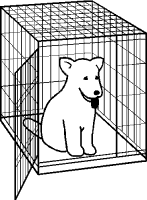 Dogs are den animals. A crate provides a secure place for your dog when you are gone, and prevents destructive habits from developing. If your dog is in his crate, he won't be chewing furniture, electrical cords, rugs, etc. A crate is also useful when house training a young dog (or re-training an older one), and is highly recommended by many responsible deaf dog owners and professional trainers.
Dogs are den animals. A crate provides a secure place for your dog when you are gone, and prevents destructive habits from developing. If your dog is in his crate, he won't be chewing furniture, electrical cords, rugs, etc. A crate is also useful when house training a young dog (or re-training an older one), and is highly recommended by many responsible deaf dog owners and professional trainers.
Dogs of any age will happily accept the crate if you introduce it slowly. The crate will become a safe haven for your dog, his own place where he is not harassed or disturbed. If you've never crate trained a dog before, you may feel guilty or negative about using a crate. It's important for the owner to accept the crate, and demonstrate a positive attitude when introducing it to his dog. If you don't feel comfortable with it, your dog won't either. There are other options if you are uncomfortable with a crate (see Crate Training or A Non-Crating Success Story).
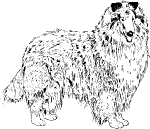 Be sure your crate is the right size for your dog. The crate should be large enough so that your full grown dog can stand up, sit, and turn around comfortably. While your dog is young, you can reduce the size of the crate with dividers (some companies sell specially made dividers that you can purchase, or you can make your own out of cardboard or plywood, cut to fit) so that your puppy won't use one end of the crate as a toilet area, and the other end to sleep in. If you choose a wire crate, you may want to consider draping a sheet over it to create a more "den-like" feel (some dogs prefer this, some don't).
Be sure your crate is the right size for your dog. The crate should be large enough so that your full grown dog can stand up, sit, and turn around comfortably. While your dog is young, you can reduce the size of the crate with dividers (some companies sell specially made dividers that you can purchase, or you can make your own out of cardboard or plywood, cut to fit) so that your puppy won't use one end of the crate as a toilet area, and the other end to sleep in. If you choose a wire crate, you may want to consider draping a sheet over it to create a more "den-like" feel (some dogs prefer this, some don't).
Allow your dog 1-2 weeks to get used to his crate (remember, every dog is different, some may take longer, some may be quicker). During this time, keep the crate in the room where you spend the most time (such as the living room or kitchen). If your dog will be sleeping in your bedroom, move the crate there at night. Eventually, you will be able to leave the crate in the bedroom (or it's chosen permanent location).
After the crate is assembled, place it in the training room you've selected with the door tied open (or removed). Start by throwing treats just inside the opening of the crate. Your dog will have to stick his head into the crate to get the treat. Be sure to praise him when he does this. For a deaf dog, praise can be petting him as he reaches for the treat, and then smiling when he looks at you. Make a game out of it. Do this until the dog is comfortable sticking his head in the crate, showing no fearfulness or hesitation. You can also start feeding the dog by placing his food dish just inside the door of the crate. Never force your dog into the crate, as this will only make him fearful and prolong the training process.
Next, you can start tossing the treat all the way to the back of the crate. First, give him a hand signal (such as "bed" or "room") before you toss the treat, then toss the treat to the back of the crate. Always use the same hand signal to tell your dog "go to your crate." Be sure to use a great treat, one that your dog will be motivated to eat. Again, praise like crazy when he fetches the treat. Repeat this until the dog is comfortable entering the crate, again showing no fearfulness or hesitation.
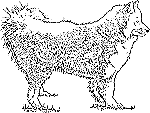 Once he is comfortable entering the crate, you can start to hold onto the treat rather than tossing it in the crate. Give him the "go to your crate" hand signal. If he enters the crate, give him the treat while he's in the crate and then let him leave. During these initial training sessions, it's important to give your dog a lot of praise and attention when he enters the crate.
Once he is comfortable entering the crate, you can start to hold onto the treat rather than tossing it in the crate. Give him the "go to your crate" hand signal. If he enters the crate, give him the treat while he's in the crate and then let him leave. During these initial training sessions, it's important to give your dog a lot of praise and attention when he enters the crate.
When he is comfortable with the previous exercise, you can begin to introduce the concept of shutting the crate door. To do this, give the dog the hand signal for "go to your crate," give him his treat, then briefly shut the door and praise him. Praise your deaf dog by keeping eye contact with him through the crate door, talk to him, smile, and let him see your face. You can also feed him additional treats through the crate door. Then open the door and let him leave the crate.
Start by keeping the door shut for a few seconds, and gradually increase to 30 seconds, then 1 minute, and so on. This process may take a few days, so don't rush it. Watch your dog closely for signs of distress, and don't push him too fast. You should stay by the crate, talking and praising your dog, during the exercises. When you let your dog out of the crate, don't make a big deal about it. Only praise when he's in the crate.
Now introduce a special crate toy that your dog only gets when he's in the crate. It can be a chew toy (such as a Nylabone), or a toy with a hole in the middle (such as a Kong). For a special treat, fill the hole with peanut butter. Again, your dog should only gets this toy when he's in the crate (and he gets it every time he goes to his crate). Be sure the toy is virtually indestructible (you do not want him to eat pieces of it when home alone).
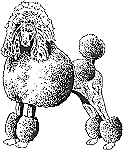 Gradually increase the amount of time your dog spends in the crate when you are at home with him. Give him the hand signal for "go to your crate," put the special toy in with him, and shut the door. Start with 2 minutes, then increase to 5 minutes, then 8 minutes, and so on. When he's comfortable in the crate for about 30 minutes, begin to leave the house for short periods of time. First, exercise your dog and give him a chance to eliminate. Then put him in the crate with his special toy, and leave the house for 5 minutes. When you return, simply let him out of the crate, don't praise excessively or make a big deal out of it. If your dog is asleep, gently open the crate door. The vibration of the door opening may wake him up. If not, wake him gently by blowing on him or gently touching him. Never bang on the crate, or shake it. Gradually increase the length of time you are gone in 5 minute increments. Remember to work slowly!! You want this to be a positive experience for your dog, and for the dog to be comfortable when you are gone.
Gradually increase the amount of time your dog spends in the crate when you are at home with him. Give him the hand signal for "go to your crate," put the special toy in with him, and shut the door. Start with 2 minutes, then increase to 5 minutes, then 8 minutes, and so on. When he's comfortable in the crate for about 30 minutes, begin to leave the house for short periods of time. First, exercise your dog and give him a chance to eliminate. Then put him in the crate with his special toy, and leave the house for 5 minutes. When you return, simply let him out of the crate, don't praise excessively or make a big deal out of it. If your dog is asleep, gently open the crate door. The vibration of the door opening may wake him up. If not, wake him gently by blowing on him or gently touching him. Never bang on the crate, or shake it. Gradually increase the length of time you are gone in 5 minute increments. Remember to work slowly!! You want this to be a positive experience for your dog, and for the dog to be comfortable when you are gone.
Tips To Remember:
- Young dogs should only be crated for short periods of time. They can be confined for approximately the number of hours equal to their age in months plus one (that is a 3 month old puppy should be able to be in his crate for 4 hours).
- Never crate your (adult) dog for more than 6-8 hours per day. Your dog should not be spending his life in a crate.
- Never let your dog out of the crate if he is barking or whining. Wait until he is quiet, even if it's only a few seconds, before you release him.
- Don't leave food in the crate with the dog as this will encourage him to eliminate in the crate. You can use a hanging water bottle, like those used on rabbit cages, to provide water for your dog.
- Teach children and other family members to respect your dog's crate. He is not to be disturbed or harassed while he's in it.
There are differing opinions on whether or not a crate should be used to "punish" a dog. It really depends on what you define as punishment. If a puppy is overexcited, and running around biting at anything and everything, he needs some time to settle down and cool off. A crate can be used for this purpose. If you are angry with your dog for something, it's better for him to be safely out of the way in his crate until you cool off, rather than underfoot where he is liable to get yelled at again. That said, putting your dog in his crate for either of these reasons should be done in a calm manner. Simply take his collar (don't grab it and yank on him), and lead him to his crate (you don't want to give a treat if the dog has done something wrong). You may want a different sign (such as "time out") rather than your normal "crate" sign (which always means "treat in crate"). Don't leave him in there too long, just enough for the both of you to settle down.
Will your dog need to be in his crate for the rest of his life? No, absolutely not! A crate is a safe place for a puppy, a safer way to travel, and a big help in house training, but once your dog has matured (generally, not before at least one year of age), he can begin to stay loose in the house when no one is home (most dogs can be loose at night in the bedroom as soon as they are reliable house trained, at about 6 months). See How to Wean Your Dog From the Crate for good directions on how to do this.
For more tips on crate training your dog, see:
- Crating Your Dog
- All About Dogs! Crate Training Your Puppy or Adult Dog
- TRAINING: Crate Training
- What Is Crate Training?
House Training
Dog owners spend a great deal of time looking down. That is because the production, cleanup and analysis of stools is a very important component of maintaining a healthy dog.
- Connie Vanacore
House training a deaf dog is no different from house training a hearing dog. A dog is generally house trained in about 2 to 3 weeks, but she may not be completely reliable until she is at least 10 months old. During adolescence (beginning at 5 to 6 months of age) some dogs may temporarily "forget" that they are house trained. Puppies under 4 months of age don't have much bowel or bladder control. A consistent schedule, combined with keeping the pup supervised or confined, are the key elements in successful house training.
Before you begin a house training program, make sure that your puppy is healthy. Bladder infections, and other health problems, can make it difficult for your pup to control his bladder/bowels. Begin by designating a corner of your yard as your dog's toilet area. Accompany your dog to this area (on leash) and wait for him to eliminate. Do not give eye contact, and do not move or follow her around. You cannot simply put your dog out the back door. You will have no way of knowing if your dog eliminates unless you are with her when it happens. Be sure to take your dog out the same door every time until she is fully trained.
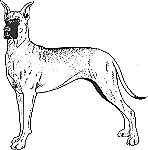 If your dog is looking at you when she eliminates, or right after she finishes, you can praise her by smiling, clapping your hands, or giving her a hand signal for "good dog" (don't worry about looking like a crazy person to your neighbors, your dog will be thrilled). If you can't praise your dog while she is eliminating (ideal situation), doing so right after will work as well (it will not hinder the house training process). The consistency of being taken to the toilet area on a regular basis teaches your dog where you want her to eliminate.
If your dog is looking at you when she eliminates, or right after she finishes, you can praise her by smiling, clapping your hands, or giving her a hand signal for "good dog" (don't worry about looking like a crazy person to your neighbors, your dog will be thrilled). If you can't praise your dog while she is eliminating (ideal situation), doing so right after will work as well (it will not hinder the house training process). The consistency of being taken to the toilet area on a regular basis teaches your dog where you want her to eliminate.
Your dog should have a regular schedule of eating, drinking, playing and sleeping. She will need to eliminate:
- Right after waking
- About 20 minutes after she finishes eating
- After playing
- After petting, grooming, or bathing
- After chewing on a toy for a while
If your dog has an accident in the house, it's your fault for not watching her closely, or not maintaining a schedule. Do not hit your dog or rub her nose in the accident, neither of these teaches the dog anything. If you catch your dog in the act, the best thing you can do is to scoop her up and then immediately take her outside to her toilet area. Although you may stomp your foot to get your dog's attention, do not continue to stomp your feet, or wave your arms, as you rush over to your dog. You want to get her attention, not scare her to death! If you are too intimidating, your dog may roll over and urinate to show her submission. Never correct submissive urination as this will only makes things worse.
Tips To Remember:
- Be sure to clean any accident areas thoroughly with a cleaner designed to neutralize pet odors (such as "Simple Solution"). A lingering scent may encourage your dog to eliminate in that spot again.
- Confine the dog when she can't be watched. Don't give her free run of the house while you work on other things (such as watching TV, cooking). Confinement can be using a leash to tether the dog to your waist, or placing the dog in a doggie pen or crate (in the same room, not isolated somewhere else). Be sure the dog has had an opportunity to eliminate before she's confined.
- Feed your dog on a schedule rather than leaving food out at all times. This makes it easier to predict when your puppy will need to go out (usually, within 30 minutes).
- Take up the water dish after the evening meal to help the dog make it through the night without waking.
- If possible, avoid paper training. Paper training teaches the dog it's okay to eliminate in the house, and makes it take that much longer and more difficult to teach the dog to go "outside."
Once your dog is consistently eliminating outside, you can teach her a sign for "potty." This can come in handy when you are in a hurry, or in a strange place and your dog isn't sure if this is a "good" place to go or not. All that you need to do is sign "toilet" while your dog is eliminating, and then reward when she is done. She will associate the sign with the process, but it may take a couple of weeks on consistent practice.
For more tips on house training your dog, see:
- Diamonds in the Rough - House Training
- Housetraining
- Dog Training Basics - Potty Training Basics
- Housebreaking Tips
- Housebreaking the Older Dog
Teaching Your Dog to Ring to Go Out
First off, you need to decide what you want to use. You can buy specially made "doggy doorbells," but all that you really need is a bell (like a cowbell on a rope, or a string of jingle bells) or windchimes hung near your door (not on the door). This can be taught to any dog, hearing or deaf.
Every time that you go outside, hold a treat behind your bell. Your dog will hit the bell with her nose to get the treat. "Good Dog" sign, and out you go. In order for your dog to understand that this bell means "potty" and not "playtime," keep her on her leash until she finishes (use the same procedure as above for house training; stand in the spot, don't move, and wait for her to finish). Once she is done, you can take off the leash and let her play if you want, or you can bring her back inside and play at a different time (don't have her ring the bell when you go out for playtime). If she doesn't eliminate within a couple minutes (try using your signal, if you have taught it), bring her back in, no play time (period).
Eventually, your dog will associate ringing the bell with going outside to eliminate, and will ring it on her own. You don't need to make a big fuss over this, just tell her "good dog" and take her out. If she backslides, and starts to ring it every 15 minutes wanting to go out, take her out on leash again until she quits.
| Home | | | FAQs | | | | | Resources | | | Rescue | | | You Can Help |
© Copyright DDEAF, 1998-2024